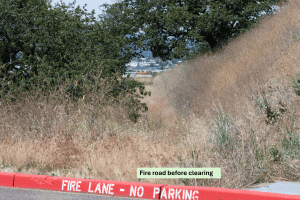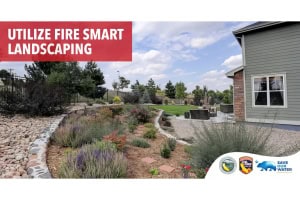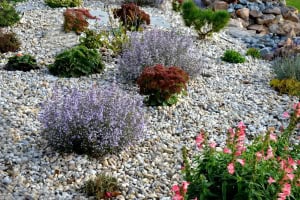Are We SAFE?
By Joni Johnson from an interview with Jody Willis (Chair of the Landscape and Grounds Committee)
Fire protection is always an issue on RVM residents’ minds during the summer. The Medford Fire Department and RVM Administration both feel that our high-rises would be safe in a fire emergency and able to withstand any kind of imminent danger. Anyone needing evacuation from the cottages would go to either the Plaza or the Manor. Last fall we had a practice run on Horizon Lane for anyone including their pets. It was very useful both for the residents and for the administration. I believe that Jens Larsen is planning one for the Quail Point side as well. And if a evacuation is required, it would be as the need arises, depending on the situation. So it might just be one street at a time if at all.
One of the issues facing RVM is the high grass in back of the health center and the Plaza. Jody Willis, as chair of the Landscape and Grounds Committee, walked the campus very recently and met with Drew Gilliland to talk about that and other issues.

Because of more rain this Spring, the grass behind the high-rises has indeed grown quite a bit. However, the grass itself poses very little danger. Even if a fire does reach it, the consensus is that it would burn very quickly and then die down because of lack of fuel. Areas that pose higher danger are where low lying branches or tree debris, especially fallen limbs, are on the ground, so the landscape crew has been cleaning up fallen debris and low branches. Before the Almeda fire, that area was used to dump landscape cuttings, but now it is primarily grasses. The grounds crew has also cut back grasses that were next to the roads. The existing roads will act as fire breaks and emergency irrigation lines will dampen the existing foliage if a fire threatens. The landscape crew has also been pruning the trees that touch any roof tops. The fire that occurred a year ago on the slope below the manor reduced fuel and fire risk in that area.

Both water conservation and fire safety make moving to sustainable gardens around each cottage really important. Every resident has the ability to make their home safer by ensuring that vegetation is about five feet away from cottage walls. In addition, it is important to use low-flammability mulch. (MULCH – materials applied to the surface of soils to enrich them and conserve soil moisture). The best option, of course, is rocks and gravel. Mulches such as decomposed granite, gravel, or rocks offer superior fire-proofing as landscape mulches and should be used when mulch is needed within five feet of buildings or near any combustible structural materials such as siding or decking. Any fallen or windblown leaf litter or debris that has collected on the rocks must be regularly removed to prevent small debris fires from igniting structures. Live plants, even when irrigated, are not recommended within five feet of buildings.
The worst kind of mulches are pine needles, red cedar bark and shredded rubber. The best organic mulch is composted wood chips, but it may difficult to find. Composted wood chips are organic and will still burn, but tend to burn at the lowest speed and lowest flame length. If this material does catch fire, it could still ignite any combustible materials. The smoldering of this product could also go undetected by firefighters during a wildfire. If you do decide to use composted wood chips as mulch, single layers are preferable to deep pockets.

Our golf courses are also a good protection against fire. As Jody said, “Yes. I am a worrier. But I think we’ve done a lot to protect the campus. We should be safe here.” And that is the general feeling here at the Manor.
Some of this info on mulch came from the following source –



Thank you, Joni, for reporting on this. Hope the fire risk will soon abate and the heat will subside.
Thank you, Joni. This is an important reminder.